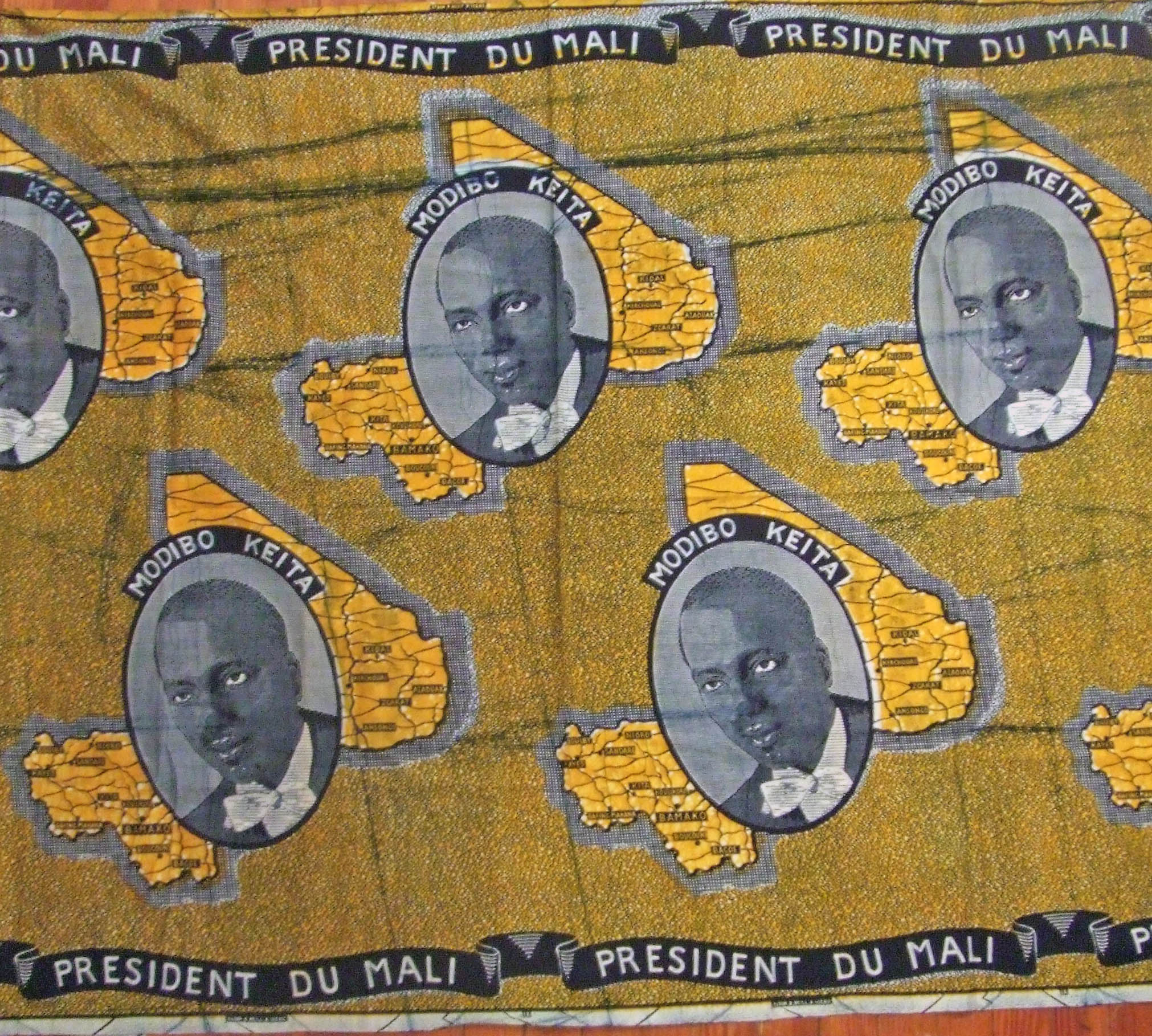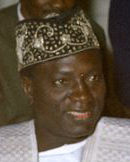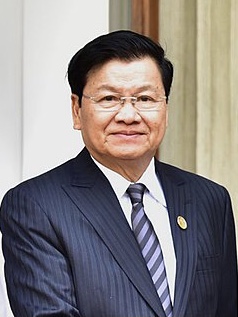 |
Modibo Keïta
Modibo Keïta (4 June 1915 – 16 May 1977) was a Malian politician who served as the first President of Mali from 1960 to 1968. He espoused a form of African socialism. He was deposed in a coup d'état in 1968 by Moussa Traoré. Born and raised in Bamako, Keïta began a career as a teacher in 1936 under French colonial rule before entering politics during the 1940s. In 1945, he co-founded the Sudanese Union (US) with Mamadou Konaté which became part of the African Democratic Rally (RDA) the following year to form the US-RDA. Being elected to several positions, his political prominence grew in the 1950s, and in 1959, he became Prime Minister of the Mali Federation, a short-lived federation of Mali and Senegal. Following the federation's collapse in 1960, Mali became an independent state, and Keïta became the new country's inaugural president. As President, Keïta soon established the US-RDA as the only official party, and began implementing socialist policies based ... [...More Info...] [...Related Items...] OR: [Wikipedia] [Google] [Baidu] [Amazon] |
 |
President Of Mali
This is a list of Head of state, heads of state of Mali since the country gained independence from France in 1960 to the present day. A total of seven people have served as head of state of Mali (excluding three acting presidents). Additionally, two people, Amadou Toumani Touré and Assimi Goïta, have served on two non-consecutive occasions. The current head of state of Mali is interim president Assimi Goïta, who took power for a second time on 24 May 2021, after dismissing previous interim president Bah Ndaw in the 2021 Malian coup d'état, 2021 coup d'état. He has since been constitutionally declared interim president of Mali. Since the 2023 Malian constitutional referendum, 2023 constitutional referendum held during Goita's leadership, Mali has shifted from a semi-presidential to a full presidential system, with the president serving as the head of government and dictating the policies of the government. Term limits As of 2021, there is a two-term limit for the president ... [...More Info...] [...Related Items...] OR: [Wikipedia] [Google] [Baidu] [Amazon] |
 |
One-party State
A one-party state, single-party state, one-party system or single-party system is a governance structure in which only a single political party controls the ruling system. In a one-party state, all opposition parties are either outlawed or enjoy limited and controlled participation in election An election is a formal group decision-making process whereby a population chooses an individual or multiple individuals to hold Public administration, public office. Elections have been the usual mechanism by which modern representative d ...s. The term "''de facto'' one-party state" is sometimes used to describe a dominant-party system that, unlike a one-party state, allows (at least nominally) multiparty elections, but the existing practices or balance of political power effectively prevent the opposition from winning power. Membership in the ruling party tends to be relatively small compared to the population. Rather, they give out private goods to fellow elites to ensur ... [...More Info...] [...Related Items...] OR: [Wikipedia] [Google] [Baidu] [Amazon] |
|
French Fourth Republic
The French Fourth Republic () was the republican government of France from 27 October 1946 to 4 October 1958, governed by the fourth republican constitution of 13 October 1946. Essentially a reestablishment and continuation of the French Third Republic which governed from 1870 during the Franco-Prussian War to 1940 during World War II, it suffered many of the same problems which led to its end. The French Fourth Republic was a parliamentary republic. Despite political dysfunction, the Fourth Republic saw an era of great economic growth in France and the rebuilding of the nation's social institutions and industry after World War II, with assistance from the United States through the Marshall Plan. It also saw the beginning of the rapprochement with France's longtime enemy Germany, which led to Franco-German co-operation and eventually to the European Union. The new constitution made some attempts to strengthen the executive branch of government to prevent the unstable situati ... [...More Info...] [...Related Items...] OR: [Wikipedia] [Google] [Baidu] [Amazon] |
|
|
Communist Study Groups
Communist Study Groups (in French: ''Groupes d'Etudes Communistes''), was a communist group in colonial French West Africa/French Equatorial Africa. GEC was founded in 1943, under the influence of the French Communist Party. GEC formed branches in the capital cities of the West African territories. GEC was primarily based amongst intellectuals. It was led by Suret-Canale and Cauche. In the 1946 French legislative elections, GEC received 1180 votes (0.9%) in Senegal. In Senegal, GEC evolved into the Senegalese Democratic Union, section of the African Democratic Rally. In Bamako, Modibo Keita was a prominent member of GEC. GEC supported his candidacy in the elections to the Constituent Assembly of the Fourth Republic in 1945. In February 1946 the first GEC group was established in French Equatorial Africa, founded by Europeans in Brazzaville Brazzaville () is the capital (political), capital and largest city of the Republic of the Congo. Administratively, it is a Department ... [...More Info...] [...Related Items...] OR: [Wikipedia] [Google] [Baidu] [Amazon] |
|
|
Daniel Ouezzin Coulibaly
Daniel Ouezzin Coulibaly (1 July 1909 – 7 September 1958) was the president of the governing council of the French colony of Upper Volta, today's Burkina Faso, from 17 May 1957 until his death on 7 September 1958 in Paris, France. A native of Pouy, today in Banwa Province, Coulibaly also served in the French national assembly from 1946 to 1951 and from 1956 to 1958, as well as in the French senate from 1953 to 1956. His wife was Célestine Ouezzin Coulibaly (1914–1997).Esi Sutherland-Addy Esi Sutherland-Addy is a Ghanaian academic, writer, educationalist, and human rights activist. She is a professor at the Institute of African Studies, where she has been senior research fellow, head of the Language, Literature, and Drama Section ..., Aminata Diaw, Judith Graves Miller, ''Des femmes écrivent l'Afrique: L'Afrique de l'Ouest et le Sahel'', 2007, p. 325: "NOUS, LES FEMMES VOLTAÏQUES Célestine Ouezzin Coulibaly est native de la région de Banfora, au sud-ouest du Burkina Fa ... [...More Info...] [...Related Items...] OR: [Wikipedia] [Google] [Baidu] [Amazon] |
|
 |
Timbuktu
Timbuktu ( ; ; Koyra Chiini: ; ) is an ancient city in Mali, situated north of the Niger River. It is the capital of the Tombouctou Region, one of the eight administrative regions of Mali, having a population of 32,460 in the 2018 census. Archaeological evidence suggests prehistoric settlements in the region, predating the city's Islamic scholarly and trade prominence in the medieval period. Timbuktu began as a seasonal settlement and became permanent early in the 12th century. After a shift in trading routes, particularly after the visit by Mansa Musa around 1325, Timbuktu flourished, due to its strategic location, from the trade in salt, gold, and ivory. It gradually expanded as an important Islamic city on the Saharan trade route and attracted many scholars and traders before it became part of the Mali Empire early in the 14th century. In the first half of the 15th century, the Tuareg people took control for a short period, until the expanding Songhai Empire absorbed ... [...More Info...] [...Related Items...] OR: [Wikipedia] [Google] [Baidu] [Amazon] |
 |
Sikasso
Sikasso ( Bambara: ߛߌߞߊߛߏ tr. Sikaso) is a city in the south of Mali and the capital of the Sikasso Cercle and the Sikasso Region. It is Mali's second largest city with 225,753 residents in the 2009 census. History Sikasso was a small village until 1870, when Tieba Traoré, whose mother came from Sikasso, became ''Faama'' of the Kénédougou Kingdom and moved the capital there. He established his palace on the sacred Mamelon hill (now home to a water tower) and constructed a massive tata to defend against the attacks of both the Malinke conqueror Samori Ture and the French colonial army. This made Sikasso the largest fortified city ever built in west Africa. Sikasso withstood a 15-month siege by Ture from 1887 to 1888 before the French, allies of Kenedougou against Ture, relieved the city. Despite this, the French contrived a diplomatic crisis to attack in 1898. They began a major artillery barrage against the tata on April 15th 1898, and the city fell on May ... [...More Info...] [...Related Items...] OR: [Wikipedia] [Google] [Baidu] [Amazon] |
 |
Dakar
Dakar ( ; ; ) is the capital city, capital and List of cities in Senegal, largest city of Senegal. The Departments of Senegal, department of Dakar has a population of 1,278,469, and the population of the Dakar metropolitan area was at 4.0 million in 2023. Dakar is situated on the Cap-Vert peninsula, the westernmost point of mainland Africa. Cap-Vert was colonized by the Portuguese people, Portuguese in the early 15th century. The Portuguese established a presence on the island of Gorée off the coast of Cap-Vert and used it as a base for the Atlantic slave trade. Kingdom of France, France took over the island in 1677. Following the abolition of the slave trade and French annexation of the mainland area in the 19th century, Dakar grew into a major regional port and a major city of the French colonial empire. In 1902, Dakar replaced Saint-Louis, Senegal, Saint-Louis as the capital of French West Africa. From 1959 to 1960, Dakar was the capital of the short-lived Mali Federation. ... [...More Info...] [...Related Items...] OR: [Wikipedia] [Google] [Baidu] [Amazon] |
|
École Normale Supérieure William Ponty
École William Ponty was a government teachers' college in French West Africa, in what is now Senegal. The school is now in Kolda, Senegal, where it is currently known as École de formation d’instituteurs William Ponty. It is associated with the French university :fr:Institut universitaire de formation des maîtres, IUFM at Livry-Gargan (France). Notable alumni Many of the school's graduates would one day lead the struggle for independence from France, including Félix Houphouët-Boigny and Bernard Binlin Dadié of Côte d'Ivoire, Modibo Keïta of Mali, Hamani Diori and Boubou Hama of Niger, Yacine Diallo of Guinea, Hubert Maga of Benin, Benin (Dahomey), Mamadou Dia of Senegal and Maurice Yaméogo and Daniel Ouezzin Coulibaly of Burkina Faso, Burkina Faso (Upper Volta).Abou Abel Thiam'"Retour à William-Ponty"in ''Jeune Afrique'', 7 Sept. 2003 :fr:André Davesne, André Davesne, author of children's books like ''Mamadou et Bineta apprennent à lire et à écrire'', and André De ... [...More Info...] [...Related Items...] OR: [Wikipedia] [Google] [Baidu] [Amazon] |
|
 |
Mali Empire
The Mali Empire (Manding languages, Manding: ''Mandé''Ki-Zerbo, Joseph: ''UNESCO General History of Africa, Vol. IV, Abridged Edition: Africa from the Twelfth to the Sixteenth Century'', p. 57. University of California Press, 1997. or ''Manden Duguba''; ) was an empire in West Africa from 1226 to 1610. The empire was founded by Sundiata Keita () and became renowned for the wealth of its rulers, especially Mansa Musa (Musa Keita). At its peak, Mali was the largest empire in West Africa, widely influencing the culture of the region through the spread of Manding languages, its language, laws, and customs. The empire began as a small Mandinka people, Mandinka kingdom at the upper reaches of the Niger River, centered around the Manding region. It began to develop during the 11th and 12th centuries as the Ghana Empire, or Wagadu, declined and trade epicentres shifted southward. The Pre-imperial Mali, history of the Mali Empire before the 13th century is unclear, as there are conflict ... [...More Info...] [...Related Items...] OR: [Wikipedia] [Google] [Baidu] [Amazon] |
|
Algeria
Algeria, officially the People's Democratic Republic of Algeria, is a country in the Maghreb region of North Africa. It is bordered to Algeria–Tunisia border, the northeast by Tunisia; to Algeria–Libya border, the east by Libya; to Algeria–Niger border, the southeast by Niger; to Algeria–Western Sahara border, the southwest by Mali, Mauritania, and Western Sahara; to Algeria–Morocco border, the west by Morocco; and to the north by the Mediterranean Sea. The capital and List of cities in Algeria, largest city is Algiers, located in the far north on the Mediterranean coast. Inhabited since prehistory, Algeria has been at the crossroads of numerous cultures and civilisations, including the Phoenicians, Numidians, Ancient Rome, Romans, Vandals, and Byzantine Greeks. Its modern identity is rooted in centuries of Arab migrations to the Maghreb, Arab Muslim migration waves since Muslim conquest of the Maghreb, the seventh century and the subsequent Arabization, Arabisation ... [...More Info...] [...Related Items...] OR: [Wikipedia] [Google] [Baidu] [Amazon] |
|
|
Morocco
Morocco, officially the Kingdom of Morocco, is a country in the Maghreb region of North Africa. It has coastlines on the Mediterranean Sea to the north and the Atlantic Ocean to the west, and has land borders with Algeria to Algeria–Morocco border, the east, and the disputed territory of Western Sahara to Morocco–Western Sahara border, the south. Morocco also claims the Spain, Spanish Enclave and exclave, exclaves of Ceuta, Melilla and Peñón de Vélez de la Gomera, and several small Plazas de soberanía, Spanish-controlled islands off its coast. It has a population of approximately 37 million. Islam is both the official and predominant religion, while Arabic and Berber are the official languages. Additionally, French and the Moroccan dialect of Arabic are widely spoken. The culture of Morocco is a mix of Arab culture, Arab, Berbers, Berber, Culture of Africa, African and Culture of Europe, European cultures. Its capital is Rabat, while its largest city is Casablanca. Th ... [...More Info...] [...Related Items...] OR: [Wikipedia] [Google] [Baidu] [Amazon] |